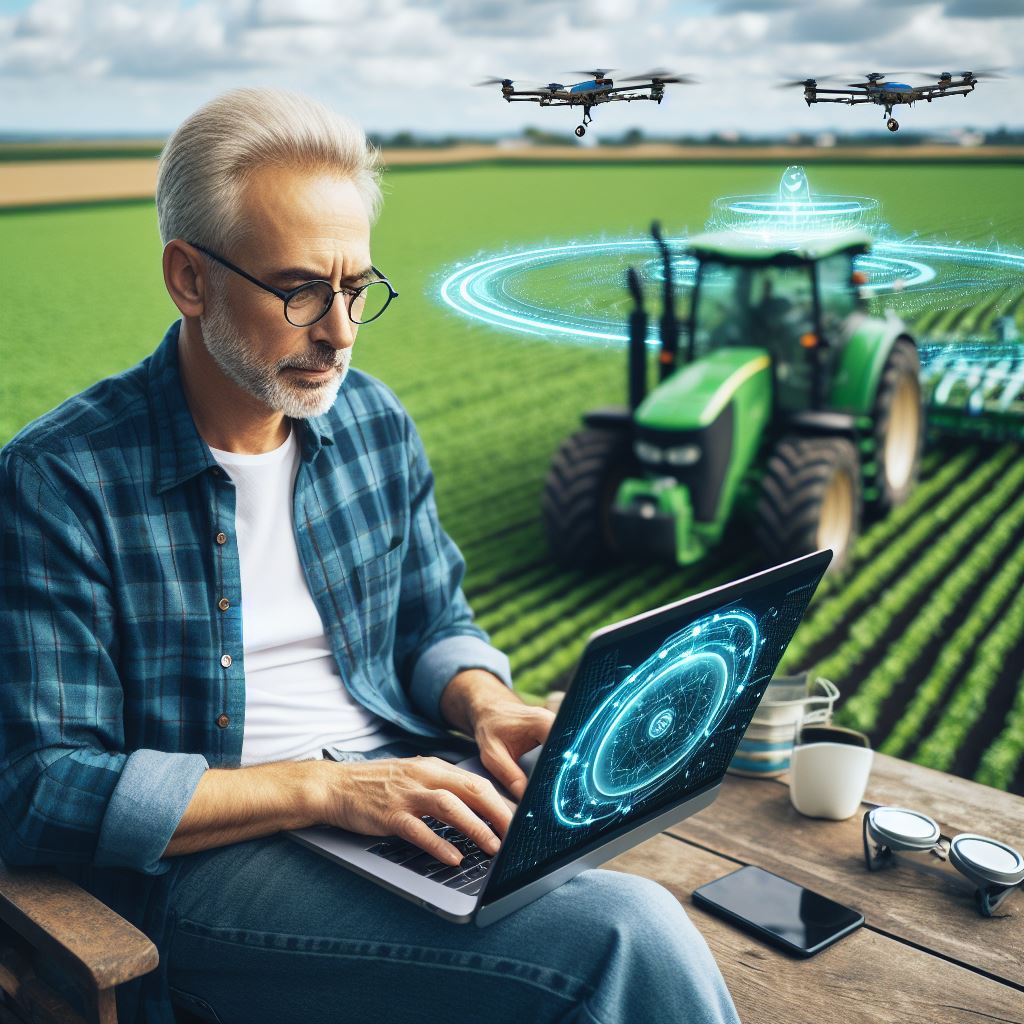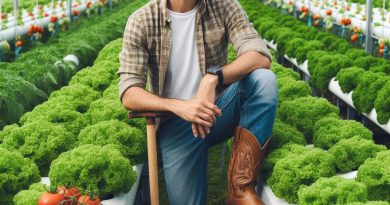AI in Agriculture: A 2024 Overview
Last Updated on January 18, 2024
Introduction
Growing importance of AI in agriculture
The importance of AI in agriculture is rapidly growing due to its potential benefits and challenges.
This blog post aims to discuss the significance of AI in agriculture and highlight its potential impact on the industry.
Potential benefits and challenges
AI technology has the potential to revolutionize agricultural practices by improving efficiency, sustainability, and productivity.
By analyzing vast amounts of data, AI can optimize crop yield, monitor soil health, and manage resources effectively.
Furthermore, AI-powered drones and robots can automate various tasks, minimizing labor requirements and reducing costs.
However, the adoption of AI in agriculture also presents challenges.
Firstly, the high cost of implementing AI technology might limit access for small-scale farmers.
Secondly, concerns regarding data privacy and security must be carefully addressed to ensure farmer trust and cooperation.
Lastly, technological literacy and training will play a vital role in ensuring successful adoption and utilization of AI in agriculture.
Purpose of the blog post
The purpose of this blog post is to provide an overview of the growing importance of AI in agriculture, highlighting its potential benefits and challenges.
By understanding these aspects, readers will gain insights into the future of AI in agriculture and its impact on the global food industry.
In the next sections, we will delve into specific applications of AI in agriculture, explore case studies, and discuss the future prospects and potential risks associated with AI-driven agriculture.
Stay tuned for an exciting and informative exploration of AI in agriculture!
What is AI in Agriculture?
Define AI and explain its role in agriculture
AI, or Artificial Intelligence, is a branch of computer science that focuses on creating machines that can perform tasks that normally require human intelligence.
AI revolutionizes agriculture by enabling machines to analyze data, make decisions, and perform tasks without human intervention, transforming farming methods.
The role of AI in agriculture is extensive. It helps farmers increase efficiency, reduce costs, and improve productivity.
By leveraging AI, farmers can make data-driven decisions, optimize resource allocation, and enhance crop yields.
AI algorithms enable machines to understand and respond to the complexities of farming, leading to better outcomes.
Various applications of AI in farming
Precision agriculture
The applications of AI in farming are diverse and encompass various aspects of agricultural processes.
One of the key applications is precision agriculture.
AI-powered drones or robots equipped with sensors and cameras can collect data on soil health, crop growth, and pest infestations.
Analysts use this data to offer farmers insights, suggesting optimal irrigation schedules, fertilizer application, and pest control strategies.
Crop management
Another important application of AI in agriculture is in the field of crop management.
Machine learning algorithms can process vast amounts of data collected from farms, such as weather patterns, soil conditions, and crop health, to predict crop diseases, nutrient deficiencies, and yield potential.
This enables farmers to take preventive measures and manage their crops more effectively.
Harvesting and sorting processes
AI technologies are also being used in harvesting and sorting processes.
Autonomous harvesting machines equipped with computer vision and AI algorithms can identify and pick ripe fruits or vegetables with precision.
This reduces labor costs and improves harvesting efficiency.
AI-based sorting systems can also classify and grade harvested produce based on quality, size, and ripeness, ensuring better market value and minimizing waste.
Livestock management
Livestock management is another area where AI is making notable advancements.
By monitoring the behavior, health, and environment of animals, AI-powered systems can detect early signs of diseases, identify heat cycles, optimize feeding schedules, and enhance breeding practices.
This not only improves animal welfare but also increases productivity and reduces losses for farmers.
Examples of AI technologies used in the industry
Several AI technologies are being used in the agricultural industry.
Computer vision
Computer vision, a subset of AI, enables machines to process, analyze, and interpret visual data.
In agriculture, computer vision is used for various tasks, including crop monitoring, disease detection, and yield estimation.
Natural Language Processing (NLP)
Natural Language Processing (NLP) enables machines to comprehend and respond to human language.
NLP can be used for voice-activated assistants or chatbots that help farmers with queries regarding farming practices and management.
Machine learning
AI’s core, machine learning, empowers machines to learn from data, enhancing performance without explicit programming.
This technology finds applications in predictive analytics, crop modeling, and disease diagnosis, among others.
Robotics and automation, combined with AI, enable the development of autonomous machines that can perform tasks such as seeding, spraying, and harvesting with precision and efficiency.
Essentially, AI is revolutionizing agriculture by enabling machines to perform complex tasks without human intervention.
It plays a vital role in precision agriculture, crop management, harvesting, sorting, and livestock management.
Industry extensively employs AI technologies like computer vision, NLP, machine learning, and robotics.
Ongoing advancements position AI to transform agriculture for a more sustainable, efficient future.
Read: Hydroponics 101: Basics & Benefits
The Benefits of AI in Agriculture
In recent years, the integration of Artificial Intelligence (AI) in agriculture has brought about numerous benefits ranging from enhanced crop production and yield to optimized resource management.
Enhancing Crop Production and Yield
AI technologies have the potential to revolutionize crop production by providing farmers with valuable insights and tools.
By analyzing large amounts of data such as weather patterns, soil conditions, and plant genetics, AI can help farmers make more informed decisions regarding planting techniques, timing, and crop selection, ultimately maximizing yield.
Furthermore, AI-powered drones equipped with sensors and cameras can monitor crop health, identify nutrient deficiencies or areas affected by pests, and alert farmers accordingly, allowing for timely interventions.
Optimizing Resource Management
AI can play a crucial role in optimizing resource management, which is vital in ensuring sustainable and efficient agricultural practices.
Through data analysis and predictive modeling, AI can assist farmers in understanding resource requirements more accurately.
For example, AI algorithms can analyze soil and weather data to determine the optimal amount of water and fertilizers needed for specific crops, reducing waste and cost.
Moreover, AI can enable precision farming techniques by providing real-time data on soil moisture levels and plant growth, allowing farmers to apply resources only where and when needed.
Improving Pest and Disease Control
AI technologies present significant potential in improving pest and disease control in agriculture.
By leveraging Machine Learning algorithms, AI systems can analyze vast amounts of data to identify patterns and detect early signs of diseases or pest infestations.
Early detection enables farmers to take proactive measures, minimizing crop damage and reducing the need for broad-spectrum pesticides.
Additionally, AI can help farmers develop targeted spraying strategies, reducing chemical usage and associated environmental risks.
Potential for Cost Reduction and Increased Profitability
One of the most appealing aspects of AI in agriculture is its potential to reduce costs and increase profitability.
By optimizing resource allocation and reducing wastage, AI can help farmers save money on irrigation, fertilizers, and pesticides.
Furthermore, AI-powered monitoring systems can help farmers detect operational inefficiencies or equipment malfunctions, enabling timely maintenance and decreasing downtime.
With AI’s ability to increase crop production and reduce losses, farmers can achieve higher yields and improved profitability.
Overall, the integration of AI in agriculture offers immense benefits ranging from enhanced production and resource management to improved pest control and increased profitability.
With further advancements and widespread adoption of AI technologies, the future of agriculture holds tremendous promise for farmers and the global food supply chain.
Read: Top 5 Trends in Vertical Farming Tech
Challenges and Risks of AI in Agriculture
As the use of artificial intelligence (AI) in agriculture grows, it is important to address and understand the challenges and risks associated with this technology.
While AI has immense potential to revolutionize farming practices, it also poses certain concerns that need to be taken into consideration.
Concerns regarding data privacy and security
- AI in agriculture relies heavily on data collection and analysis, raising concerns about the privacy and security of farmers’ information.
- Data breaches and unauthorized access to sensitive agricultural data can have detrimental effects on farmers and the industry as a whole.
- It is crucial to establish robust data protection measures and regulations to ensure the safe and responsible use of AI technology in agriculture.
Potential ethical considerations of AI use in farming
- One ethical consideration revolves around the use of AI to automate various farming tasks, potentially leading to job displacement and economic inequalities.
- Additionally, the use of AI in decision-making processes raises questions about who bears responsibility for any negative outcomes or mistakes made by the technology.
- Transparent guidelines and ethical frameworks should be developed to mitigate these concerns and ensure the fair and responsible use of AI in agriculture.
The risks of over-dependence on AI technology
- While AI can greatly improve farming efficiency, an over-reliance on this technology might create vulnerabilities in the agricultural system.
- Hardware or software failures, power outages, or cyberattacks could disrupt the entire farming process if farmers become too dependent on AI systems.
- It is crucial to strike a balance between utilizing AI capabilities and maintaining traditional farming methods as backup systems.
Challenges of implementing AI in traditional farming practices
- Adopting AI in traditional farming practices faces challenges related to cost, technical expertise, and accessibility for small-scale farmers.
- Implementing AI systems may require additional infrastructure, training, and ongoing technical support, which might be burdensome for some farmers.
- Efforts should be made to provide adequate resources, support, and training to ensure that all farmers can benefit from AI advancements in agriculture.
By acknowledging and addressing these challenges and risks, the agricultural industry can harness the full potential of AI while minimizing any negative effects.
Establish regulations and ethics to safeguard farmers’ data, ensuring responsible AI use in farming. Exercise caution to prevent excessive reliance on AI, supporting its integration in traditional farming.
With proper planning and consideration, AI can revolutionize the agriculture sector, improving productivity, efficiency, and sustainability.
Read: Soil Health Monitoring: New Tech Trends

Current and Future Trends of AI in Agriculture
In this section, we will explore the current adoption of AI in farming and discuss emerging trends and technologies in AI for agriculture.
Additionally, we will examine the potential impacts of AI advancements in the future.
Overview of the Current Adoption of AI in Farming
- Farmers are increasingly embracing AI technologies to optimize their operations and improve crop yields.
- AI is being used in agriculture for various tasks including crop monitoring, irrigation management, and pest control.
- Remote sensing and satellite imagery are used to collect data, which is then analyzed by AI algorithms.
- This data-driven approach helps farmers make informed decisions and identify potential issues before they become significant problems.
- The adoption of AI in farming is still relatively low compared to other industries, but it is growing steadily.
Emerging Trends and Technologies in AI for Agriculture
- Machine learning algorithms are being developed to predict crop diseases and identify optimal planting conditions.
- Robots equipped with AI capabilities are being used for tasks such as planting, harvesting, and sorting crops.
- AI-powered cameras on drones actively monitor crops, detecting pest infestation or nutrient deficiency through aerial observations.
- AI-driven data analysis develops data analytics platforms, empowering farmers with actionable insights.
- AI-powered sensors and smart devices are being used to monitor soil moisture, temperature, and nutrient levels.
Potential Impacts of AI Advancements in the Future
- AI has the potential to revolutionize agriculture by increasing efficiency, reducing costs, and improving sustainability.
- With AI-powered systems, farmers can optimize resource allocation, minimizing water usage and reducing the need for chemical inputs.
- Precision agriculture techniques made possible by AI can lead to higher crop yields and better quality produce.
- AI can help address labor shortages in agriculture by automating repetitive tasks and reducing the need for manual labor.
- Furthermore, AI can enable real-time monitoring and early detection of crop diseases, enabling timely intervention and minimizing crop losses.
In general, the adoption of AI in agriculture is steadily increasing, with farmers leveraging AI technologies to optimize their operations and make data-driven decisions.
Emerging trends such as machine learning, robotics, drones, and data analytics platforms are revolutionizing farming practices.
The future impacts of AI advancements in agriculture are promising, including increased efficiency, reduced costs, improved sustainability, and higher crop yields.
The integration of AI in farming has the potential to address challenges such as labor shortages and crop diseases, ensuring a more secure and prosperous future for the agricultural industry.
Read: Hydroponics: Water-Smart Farming Future
Case Studies: Successful AI Implementation in Agriculture
In this section, we will explore case studies of successful AI implementation in agriculture.
AI technologies actively transform farming, showcasing real-life examples and revealing the achieved outcomes and benefits of adoption.
Case Study 1: Precision Farming
One example of successful AI implementation in agriculture is precision farming.
Farmers use advanced sensors and AI algorithms to monitor crop health and optimize inputs.
- AI-powered drones collect data on crop growth, soil moisture, and nutrient levels.
- The data is then processed using AI algorithms to provide actionable insights for farmers.
- By tailoring irrigation and fertilizer application, farmers can optimize crop production and reduce waste.
Case Study 2: Crop Disease Detection
AI is also being used to identify crop diseases early, reducing crop losses and improving yields.
- Machine learning models analyze images of crops to detect disease symptoms.
- Farmers can use smartphones or drones to capture images, which are then analyzed by AI algorithms.
- Early detection allows farmers to take prompt action, such as targeted treatment or quarantining affected areas.
- This leads to reduced pesticide use and improved overall crop health.
Case Study 3: Livestock Monitoring
AI technologies are also being employed to monitor and manage livestock more efficiently.
- AI-powered sensors collect data on animal behavior, health, and productivity.
- Machine learning algorithms analyze this data to identify patterns and detect anomalies.
- Farmers can receive real-time alerts for issues such as illness, distress, or calving.
- By monitoring livestock more effectively, farmers can improve animal welfare and reduce losses.
Benefits of AI Adoption in Agriculture
The successful implementation of AI in agriculture brings numerous benefits to farmers and the industry as a whole.
- Increased productivity: AI technologies enable farmers to optimize inputs and maximize crop yields.
- Reduced environmental impact: Precision farming and disease detection help minimize the use of pesticides and fertilizers.
- Cost savings: AI can help reduce labor and resource costs, making farming more economically sustainable.
- Improved decision-making: AI provides real-time insights and predictions, aiding farmers in making informed choices.
Lessons Learned and Best Practices
Through these case studies, several lessons can be learned for successful AI implementation in agriculture:
- Start small: Begin with pilot projects to test AI technologies and their compatibility with existing systems.
- Collaboration is key: Engage with AI experts, farmers, and industry stakeholders to develop tailored solutions.
- Data quality matters: Accurate and reliable data is crucial for training AI algorithms and obtaining accurate results.
- Continuous learning: AI models need to be regularly updated and refined to adapt to changing agricultural conditions.
In essence, these case studies highlight the successful use of AI technologies in agriculture.
From precision farming to livestock monitoring, AI has proven to bring tangible benefits, including increased productivity, reduced environmental impact, cost savings, and improved decision-making.
By following best practices and lessons learned, more farmers can harness the power of AI to optimize their operations and contribute to the sustainable development of agriculture.
Conclusion
Key points discussed in the blog post
This blog post highlighted the significant role that AI plays in agriculture.
Throughout the discussion, we explored various applications of AI in farming, such as crop monitoring, precision agriculture, and livestock management.
We also delved into the benefits brought by AI technology, including increased productivity, optimized resource utilization, and improved decision-making.
Emphasis on the potential of AI in shaping the future of agriculture
The potential of AI in shaping the future of agriculture is undeniable.
With AI-powered solutions, farmers can overcome challenges like climate change, population growth, and resource constraints.
The ability to collect and analyze vast amounts of data allows for more accurate predictions, optimized crop management, and early detection of plant diseases.
By harnessing the power of AI, agriculture can become more sustainable, efficient, and resilient.
Encouragement to stay informed and explore AI opportunities in farming
As technology continues to advance, it is essential for farmers and stakeholders in the agricultural industry to stay informed about the latest developments in AI.
Keeping up with AI opportunities can provide valuable insights and potential advantages for farmers, enabling them to make informed decisions and maximize their productivity.
Embracing AI in farming can lead to improved crop yields, reduced waste, and increased profitability.
In a nutshell, we encourage readers to explore the vast opportunities of AI in agriculture.
Familiarize yourself with AI applications, such as machine learning algorithms, satellite imagery, and robotics, to make the most out of this transformative technology.
By integrating AI into farming practices, we can ensure a more sustainable and prosperous future for agriculture, meeting the challenges of an ever-growing global population.
Stay informed, adapt, and seize the potential of AI in farming!


